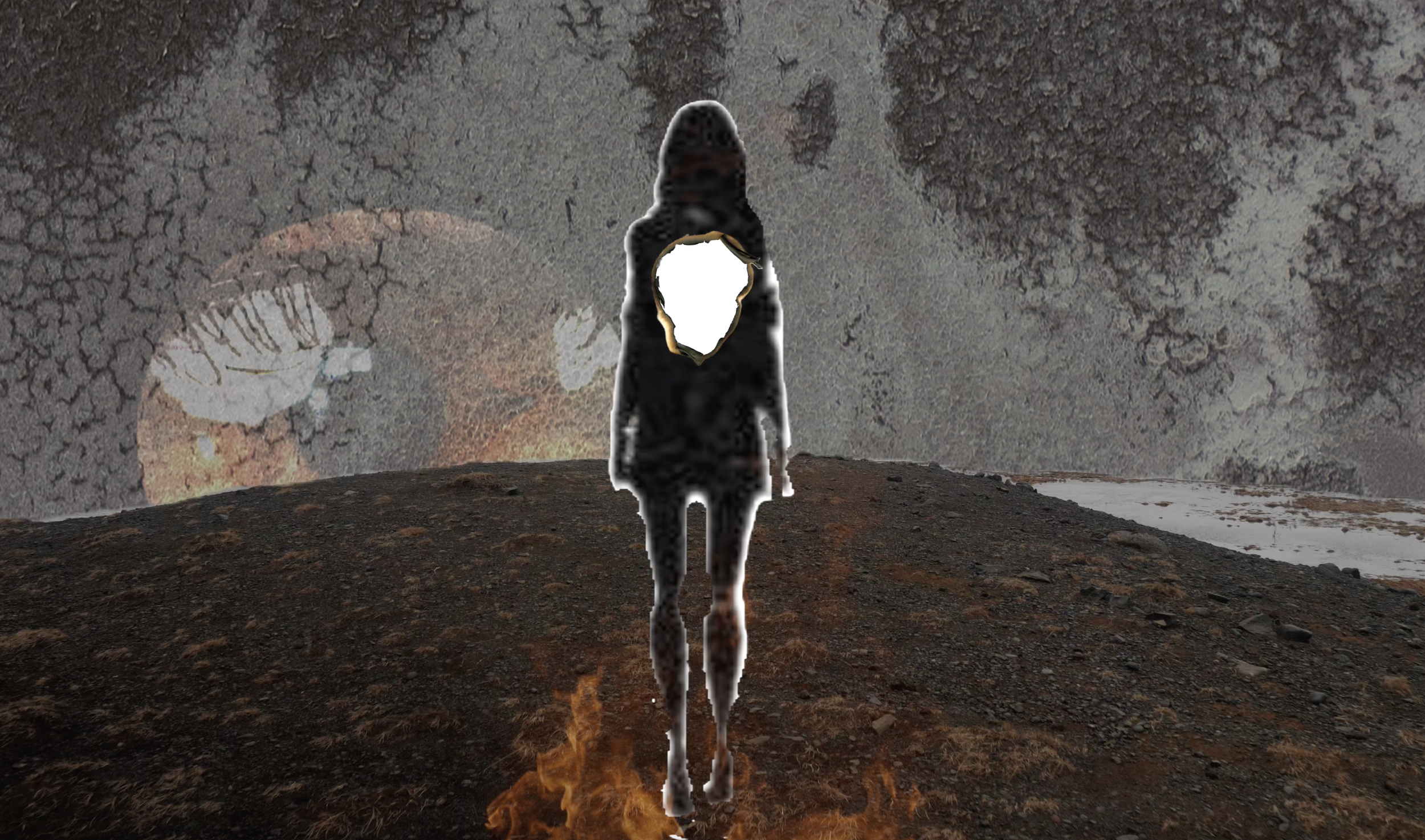Diana Meridi
Diana Meridi stands as a remarkable figure within the contemporary video art scene, her work traversing boundaries between the tangible and the mystical, between the corporeal and the metaphysical. She creates with an intensity and precision reminiscent of seminal figures in experimental cinema, such as Maya Deren, and echoes the conceptual depth of video artists like Bill Viola. Yet, Meridi remains entirely singular in her approach, cultivating an aesthetic that is deeply introspective, visually enchanting, and philosophically profound.
One of the defining aspects of Meridi’s oeuvre is her ability to create layered, internal universes. Her video art frequently invokes a dreamlike quality, where fictional characters, fantastical landscapes, and recurring symbols such as the eye converge to form a cohesive narrative. This motif—the eye—recurs throughout her work as an emblem of divinity, surveillance, and transcendence. It suggests a higher power, a hidden truth, or an omnipresent gaze that influences the trajectories of the characters and settings within her videos. The eye is not merely a visual element but a philosophical anchor, inviting viewers to question their own relationship with the unseen forces that govern existence.
Her work "Whispers of the City." This video art piece delves into the subtle interplay between the urban landscape and the psyche of its inhabitants. The city becomes a sentient being, pulsating with light, shadow, and ephemeral whispers that seem to emanate from the very walls and pavements. Meridi’s technique of blending real urban imagery with surreal overlays of flowing, organic textures results in a visual language that captures the ineffable spirit of place. The video does not merely depict a city; it transforms the city into a living, breathing entity that is simultaneously familiar and alien. Her use of layered soundscapes—ambient noise interwoven with whispered fragments of speech—further reinforces the mystical, almost spiritual, quality of the piece.
In "Dreamscape Echoes," Meridi ventures even further into the realm of the unconscious. This work is a study of memory, longing, and the fragmented nature of human experience. The visual narrative is composed of flowing transitions between ethereal landscapes, figures that flicker and dissolve, and celestial motifs such as moons and stars. These symbols are not mere decoration; they resonate with the viewer on an archetypal level, evoking Jungian ideas of the collective unconscious. The recurring motif of wings and transformation in this piece suggests a yearning for transcendence, an attempt to escape the confines of the material world and reach a higher state of being. This echoes the themes found in the works of avant-garde filmmakers like Andrei Tarkovsky, whose contemplative pacing and metaphysical preoccupations find a kindred spirit in Meridi’s art.
The visual sophistication of Meridi’s work is matched by her innovative approach to technique. Her use of motion graphics in "Fantastic Magical Glitter Lights" exemplifies her mastery over digital tools, as well as her ability to create hypnotic, immersive environments. The interplay of light and color in this piece is mesmerizing, forming a kaleidoscopic world that simultaneously feels expansive and intimate. While this work may initially appear to be a celebration of aesthetic beauty, it subtly interrogates the relationship between the viewer and the spectacle. By drawing attention to the act of seeing, Meridi challenges the audience to consider how visual experiences shape their perception of reality.
Meridi’s philosophical inquiry—the search for hidden truths and the divine presence within the everyday—is a unifying thread throughout her body of work. In this, she aligns with the tradition of artists like Bill Viola, whose video installations also explore themes of transcendence and spirituality. Yet, Meridi’s approach is distinctly her own, marked by an emphasis on the mystical and the occult. She draws from a wide range of influences, from mythological archetypes to contemporary explorations of technology and media, weaving them into a cohesive vision that feels both ancient and futuristic.
One cannot overlook the profound emotional resonance in Meridi’s work. The haunting imagery in her videos—such as the silhouetted figure with a hollowed chest in "Whispers of the Celestial"—evokes a sense of vulnerability and longing. Her characters often appear as archetypes rather than individuals, embodying universal human experiences of fear, desire, and transcendence. In this way, Meridi’s art transcends the specificities of time and place, resonating on a deeply human level.
In "Butterfly Visions," Diana Meridi continues her exploration of the mystical, symbolic, and transformative aspects of human perception, further cementing her unique artistic vision. This work expands upon her established themes of transcendence and the unseen forces that shape existence while introducing new layers of metaphor and visual language.
The butterfly is a powerful and multifaceted symbol, representing transformation, fragility, and the ephemeral nature of life. In "Butterfly Visions," Meridi positions the butterfly as both a literal and metaphorical lens through which the viewer encounters the world. The piece juxtaposes close-up imagery of butterfly wings—intricate, symmetrical, and otherworldly—with recurring imagery of the human eye, a motif that has become central to her oeuvre. The butterfly’s delicate patterns and the eye’s organic textures serve as mirrors of one another, reinforcing the themes of observation and metamorphosis.
The butterfly, as a symbol of transformation, aligns perfectly with the broader philosophical questions Meridi’s work raises: How do we evolve? How do we perceive change? And how are we shaped by forces beyond our control? This connection recalls the works of Salvador Dalí, whose surrealistic imagery often used insects to explore similar themes of time, decay, and renewal.
Visually, "Butterfly Visions" demonstrates Meridi’s mastery of layering and motion. The piece interweaves fluid, kaleidoscopic transitions between the butterfly and other imagery, such as fragmented human forms, celestial spheres, and abstract, pulsating patterns. This dynamic layering evokes a feeling of constant flux, as if the entire visual narrative is in a state of perpetual transformation. This style situates Meridi in dialogue with artists such as Stan Brakhage, whose experimental films also explore the organic and tactile qualities of the visual experience.
The pacing of "Butterfly Visions" is meditative yet charged with energy. Each scene lingers just long enough to immerse the viewer in its intricate details, but not so long that the viewer feels anchored. This temporal fluidity mirrors the transient, fleeting beauty of the butterfly itself, creating a rhythm that is hypnotic and dreamlike.
The soundscape of "Butterfly Visions" plays an equally vital role in its impact. Meridi combines soft, ambient sounds—wind, whispers, and the faint rustle of wings—with intermittent, rhythmic pulses that mimic the beating of the butterfly’s wings. This auditory texture creates an almost tactile connection between the visual and aural elements, enveloping the viewer in a sensory experience that feels immersive and deeply personal.
The emotional resonance of the work emerges through its contrasts. The ethereal beauty of the butterfly wings is set against darker, haunting imagery—a silhouetted figure in shadow, an eye submerged in darkness, and flashes of decayed landscapes. This interplay of light and shadow evokes a tension between hope and despair, beauty and fragility, transformation and destruction. It feels as though Meridi is reminding us that change, though beautiful, often comes with a cost.
At its core, "Butterfly Visions" is a meditation on perception and transformation. The eye and the butterfly, as central motifs, serve as metaphors for two interconnected processes: the act of seeing and the act of becoming. The eye, symbolizing awareness, implies that transformation begins with observation—with seeing ourselves and the world clearly. The butterfly, on the other hand, embodies the result of that transformation, the delicate and ephemeral state of having changed.
This philosophical depth aligns "Butterfly Visions" with Meridi’s broader body of work, particularly in its engagement with the ineffable. The piece invites viewers to consider their own processes of transformation: How do we grow and change? What do we see, and what do we fail to see, in the midst of these changes? And, ultimately, what is the cost of transformation in a world that is both beautiful and fragile?
While "Butterfly Visions" maintains continuity with Diana Meridi’s other works—such as "Dreamscape Echoes" and "Whispers of the City"—it also represents a refinement of her style and a deeper engagement with the symbolic. The butterfly as a central figure introduces a new layer of archetypal resonance, situating the work within a lineage of artists who have explored similar themes of metamorphosis, from Louise Bourgeois to contemporary video artists like Pipilotti Rist.
"Butterfly Visions" continues Meridi’s exploration of the divine and the mystical in everyday existence. The recurring focus on the eye suggests a spiritual or transcendental gaze—a vision that sees beyond the surface, beyond the immediate, and into the realm of the eternal. This emphasis on the unseen resonates strongly with the mystical philosophies of the occult and the surrealist movement, grounding Meridi’s work within a broader historical context while remaining unmistakably contemporary.
As we witness Meridi’s career unfold, it becomes clear that her work is not only a reflection of her artistic vision but also a mirror held up to the human condition. Through her exploration of the symbolic, the mystical, and the transcendental, Diana Meridi invites us to see the world anew—to glimpse the divine in the mundane and to find meaning in the spaces between light and shadow. Her art is a testament to the enduring power of creativity to illuminate the unseen and to connect us with something greater than ourselves. Diana Meridi’s place within the contemporary art scene is both prominent and essential. In an era where much of video art has turned toward overt political commentary or technological experimentation for its own sake, Meridi’s work stands out for its deeply personal and philosophical focus. She reminds us that art has the power to probe the mysteries of existence, to create spaces where the ineffable can be felt, if not fully understood. Her videos are not mere spectacles; they are invitations to reflect, to feel, and to connect with the unseen forces that shape our lives.
Comparisons to filmmakers such as Tarkovsky or experimental artists like Deren are apt but not exhaustive. While these figures provide a lens through which one can begin to understand Meridi’s work, her art ultimately defies easy categorization. She is not merely following in the footsteps of her predecessors; she is carving out a path that is uniquely her own. Her blend of mysticism, narrative complexity, and technical innovation places her at the forefront of contemporary video art, ensuring that her contributions will be remembered as both pioneering and transformative.
Diana Meridi’s video art exemplifies the profound power of contemporary creative expression. By merging philosophical depth with technical mastery, she challenges audiences to explore the unseen layers of existence and to confront the mystery of transformation. Her works stand as bridges between the mystical and the tangible, the poetic and the rational, offering insights that resonate across time and place.
By Marta Puig
Editor Contemporary Art Curator Magazine













